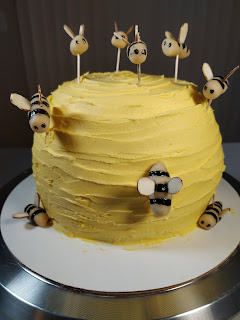This week’s bake is a Brown-Butter Banana Beehive Cake from Zoë François of Zoe Bakes
It’s four layers of brown-butter banana cake, filled with a peanut butter and honey buttercream and topped with homemade marzipan bees. The shape of the cake is based on an ancient beehive called a skep.
Bees of all kinds belong to the order of insects known as Hymenoptera, literally “membrane wings”. This order, comprising some 100,000 species, also includes wasps, ants, ichneumons and sawflies. Of the 25,000 or more described species of bees (more are recognised every year) the majority are solitary bees most of which lay their eggs in tunnels, which they excavate themselves.
Honey bees belong to the family of social bees which includes bumble bees and the tropical stingless bees of the genus Meliponinae. The sub-family Apinae or honey bees, comprises a single genus, Apis, which is characterised by the building of vertical combs of hexagonal cells constructed bilaterally from a midrib, using only the wax secreted by the worker bees. The cells are multi functional, being used repeatedly for rearing the larvae and for the storage of honey and pollen. Progressive feeding of the larvae is carried out by young bees with food produced by glands in the head of the bee from honey and pollen.
Bees probably appeared on the planet about the same time as flowering plants in the Cretaceous period, 146 to 74 million years ago. The oldest known fossil bee, a stingless bee named Trigona prisca, was found in the Upper Cretaceous of New Jersey and dates from 96 to 74 million years ago.
In 2007, honey bees began disappearing. Beekeepers across the United States reported that adult worker bees were leaving their nests, queens, larvae, and resources with no apparent cause. Large, industrial bee keepers suffered dramatic losses. Colony collapse disorder (CCD) brought public attention to the importance of pollinators, human impact on their health, and the consequences of their potential loss.
The most pressing threats to long-term bee survival include:
Climate change
Habitat loss and fragmentation
Invasive plants and bees
Low genetic diversity
Pathogens spread by commercially managed bees
Pesticides
What can I do to help bees?
Build a pollinator garden with wildflowers
Enhance nesting spots
Be cautious with pesticides
Here is the recipe:
Ingredients
Brown-Butter Banana Cake
1 cup (226 grams) unsalted butter, at room temperature, plus more for the pan and bowl
2 1/2 cups (300 grams) all-purpose flour, plus more for the pan and bowl
1 cup (200 grams) granulated sugar
1/2 cup (170 grams) honey
1 teaspoon pure vanilla extract
2 large eggs, at room temperature
1 1/2 cups (400 grams) banana puree (about 4 bananas)
1 1/2 teaspoons baking powder
3/4 teaspoon baking soda
1/2 teaspoon kosher salt
1 1/2 teaspoons ground cinnamon
1/2 cup buttermilk
American Buttercream Frosting:
1 1/2 cups (340 grams) unsalted butter, at room temperature
4 cups (460 grams) confectioners’ sugar
1/2 cup (170 grams) honey
2 teaspoons pure vanilla extract
1/3 cup (80 grams) peanut butter
Yellow gel paste food color
Marzipan Bees
1/4 cup marzipan
1/4 cup sliced almonds
Black gel paste food color
Directions
To make the banana brown-butter cake:
Preheat the oven to 350°F.
Butter and flour an 8-inch cake pan and an 8-inch metal mixing bowl.
Line the cake pan with a parchment paper round. Set aside.
In a small saucepan, cook the butter over low heat until the butter is caramel colored and smells toasty.
Strain the butter into a stand mixer fitted with the paddle attachment, then beat together the butter, granulated sugar, honey, and vanilla until it is cooled off slightly.
Add the eggs one at a time, mixing well after each.
Add the banana puree and mix until incorporated.
In a medium bowl, whisk together the flour, baking powder, baking soda, salt, and cinnamon. Set aside.
Alternate adding the flour mixture and buttermilk to the butter mixture, starting and ending with the dry ingredients.
Divide the batter between the prepared cake pan and bowl.
Bake the cakes until a tester comes out clean, about 40 minutes.
The cake in the bowl may take a few more minutes. Remove and allow to cool completely.
To make the American buttercream frosting:
In a stand mixer fitted with the paddle attachment, beat the butter until soft and smooth.
Add the confectioners’ sugar and mix on low until incorporated.
Add the honey and vanilla.
Turn the speed up and beat until light, fluffy, and spreadable, about 2 minutes.
Divide the buttercream in half and add peanut butter to one batch and the yellow food coloring to the other.
To cut and fill the cakes:
Slice each of the layers in half, then fill the layers with the peanut-butter buttercream.
Using a small amount of the yellow buttercream, create a crumb coat to lock in the crumbs and smooth the surface of the cake.
Freeze the cake for about 20 minutes.
Put a nice thick layer of yellow buttercream over the chilled crumb coat.
Starting at the top of the beehive cake, use an icing spatula and create a spiral by slowly spinning the revolving cake stand and moving the spatula downward.
To create the marzipan bees:
Take a small piece of the marzipan and roll it between the palms of your hands until it is lozenge shaped.
You can taper one end slightly to be the back of the bee.
Paint the stripes on the marzipan with a clean paintbrush or toothpick and black food coloring. Allow it to dry until it is no longer tacky.
Once the stripes are dry, press the sliced almonds into the sides to create the bees’ wings.
Use toothpicks to attach some of the bees to the top of the cake and arrange others on the cake plate as desired.
Here are some pictures from the bake:
Have a great day!








Comments
Post a Comment